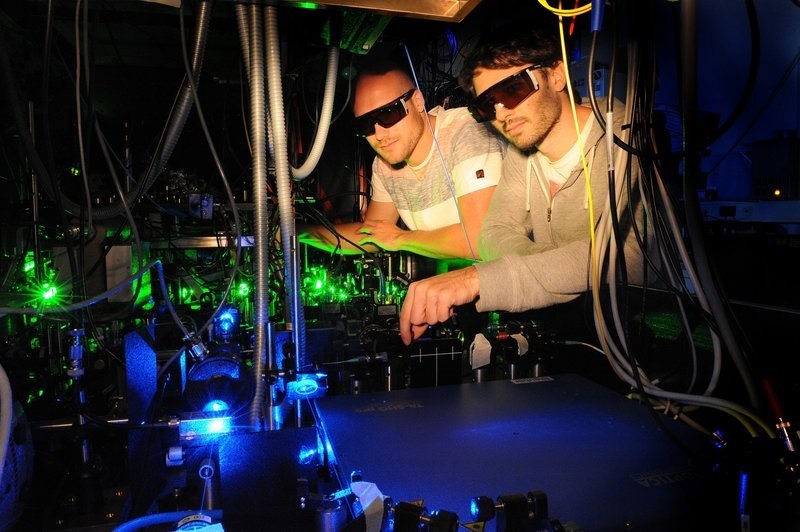Recent advances in quantum research have made it possible to map the strong interactions between Rydberg atoms on optical photons by making use of electromagnetically induced transparency. Now, for the first time, researchers at the Max Planck Institute of Quantum Optics have exploited this mechanism to implement a photon-photon quantum gate. This all-optical logic gate provides precise control over single photons, and its realization opens a route to new applications in quantum communication and quantum networks.
October 29, 2018
Since the early years of the century, scientists have been seeking ways to exploit the properties of Rydberg atoms for photon-based processing of quantum information. “We have now taken an important step towards this goal,” says Steffen Schmidt-Eberle, a PhD student in the Max Planck Institute of Quantum Optics at the Garching Research Campus near Munich. Under the supervision of Stephan Dürr and Gerhard Rempe, the Director of the Division of Quantum Dynamics, he has been working with a team of researchers on the development of a photon-photon quantum gate since 2014.
Rydberg atoms interact strongly with each other, and are therefore ideal for processing quantum information. The idea behind the project is to map this well-known strong interaction between Rydberg atoms on light, and use it as a means of implementing a logical operation between two light quanta or photons. Such a controlled procedure is a basic prerequisite for the correct processing of quantum information in an optical quantum network.
“The ability to control light and its properties is playing an increasingly important role in the modern world. It provides the basis for what are now routine applications in fields ranging from medicine to materials processing and high-speed data transmission. This explains why one major goal of research in this area is to find ways of manipulating the behavior of single photons with similar efficiency and versatility,” says Schmidt-Eberle.
Photons enable information to be disseminated very rapidly and with high bandwidths. That is why optical technologies have become the standard for transmission of data across the Internet. Future quantum-based technologies will most probably make use of these particular properties of photons to transmit quantum states and thus quantum information between the different nodes of quantum networks.
Initial attempts to harness light quanta not just for the transmission but for the processing of information failed, because photons do not normally interact with one another. The research group led by Dürr and Rempe at the Max Planck Institute of Quantum Optics has now solved this problem by demonstrating a practical method for coupling photons to Rydberg atoms, in which an electron is excited into a high-energy state. By taking advantage of the strong interaction between such atoms, they were able for the first time to create an effective interaction between photons and use it to realize a photon-photon quantum gate. In a future quantum computer or network, such photon-based quantum logic gates could play a role similar to that of the CPU in a classical computer.
The experimental approach successfully used to create the all-optical logic gate consists of the following steps. First, the researchers cool a cloud of atoms to a temperature of 1 microkelvin – only a whisker above absolute zero. A first photon is stored in this medium as a Rydberg excitation. They then send a second photon into the cloud. Finally, they retrieve the first photon and measure the polarization of both photons when they emerge from the cloud. Thanks to its interaction with the Rydberg excitation, the influence of the first photon sent into the cloud on the second turns out to be so strong that the polarization of the second, depending on the polarization of the first photon, is rotated by 90 degrees from its input direction. “The very fact that one can achieve such a large effect using a single photon is fascinating,” says Schmidt-Eberle.
“One of the major difficulties associated with this experiment – making the interaction strong enough that the rotation angle of the polarization was not too small – was resolved two years ago. The second challenge was to ensure that the rotation is not contingent on whether or not the first photon is irradiated, but depends on its polarization,” explains Stephan Dürr, who led the project. In order to solve that problem, the team had to identify appropriate atomic states to which the photons could be coupled, and then to actually implement the coupling interaction technically.
“The search for ways to generate an effective interaction between photons by means of Rydberg atoms is a young and dynamic area of research, which has made it possible to demonstrate optical non-linearity at the level of single photons. The realization of an optical quantum gate based on Rydberg interactions is a critical milestone in the development of the field, which demonstrates that the properties of a photon can be maximally altered by the influence of a second single photon,” Dürr adds.
Gerhard Rempe provides the following assessment of the team’s achievement: “Our experiments provide the first proof that it is in fact possible to process quantum information between photons with the aid of Rydberg systems. That in itself is a major step towards the realization of a highly efficient photon-photon quantum gate.”
Original Publication
Daniel Tiarks, Steffen Schmidt-Eberle, Thomas Stolz, Gerhard Rempe,
Stephan Dürr
A Photon-Photon Quantum Gate Based on Rydberg Interactions
Nature Physics, October 29th, 2018
doi: 10.1038/s41567-018-0313-7















